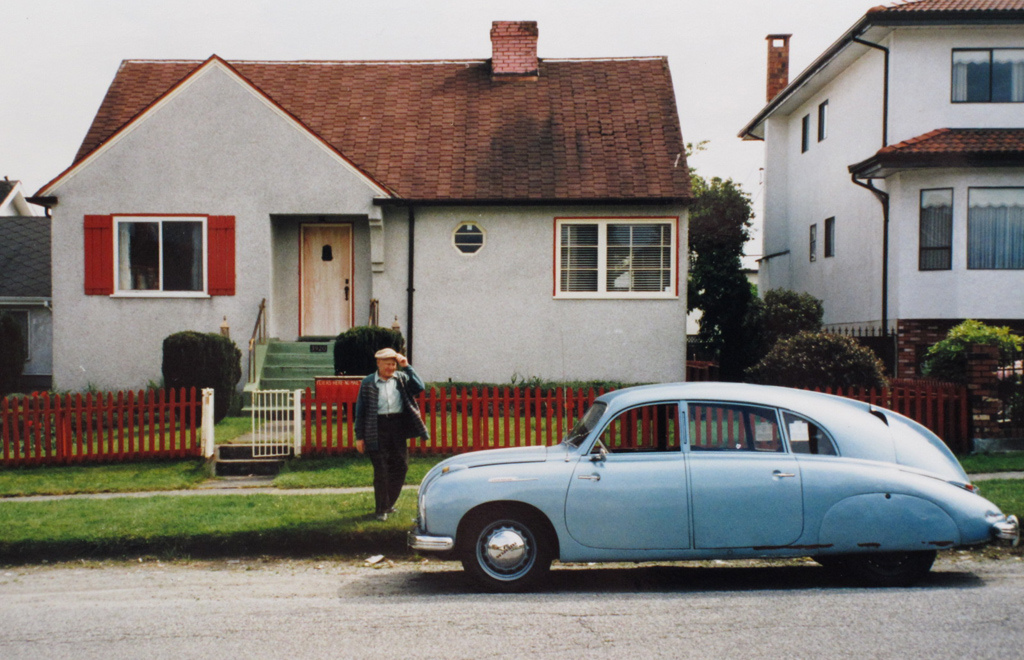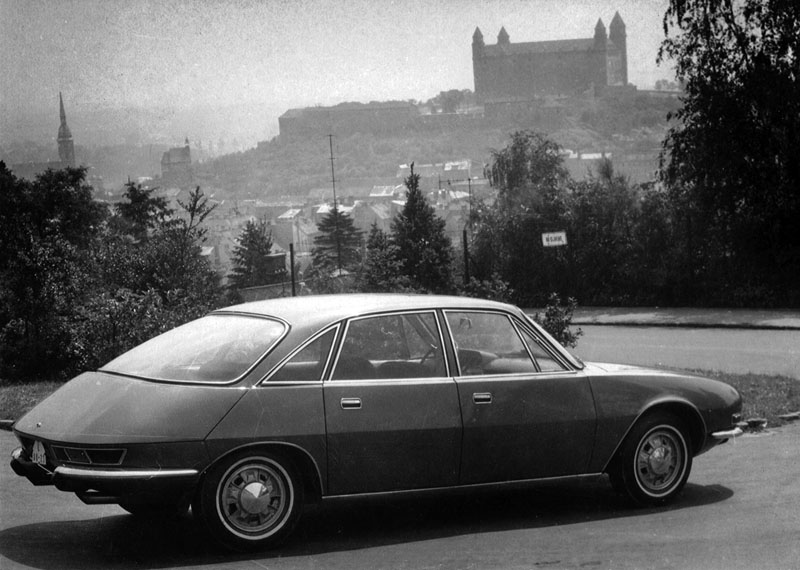Glänzende Limousinen als Repräsentanten einer vergangenen Zeit (English text below)
Angermünde (MOZ) Sie glänzen im wahrsten Sinne des Wortes vor Eleganz und aristokratischem Charakter. Einst fuhren sie vor allem Staatsoberhäupter und Wirtschaftsbosse mit Chauffeuren, heute sind es Raritäten, Lieberhaberstücke einer untergegangenen Automobillegende – Tatras. Die größte, einzigartige Sammlung der tschechischen Pkw-Marke ist in Angermünde zu sehen. Die Tatra-Galerie Riesebeck bewahrt Modelle aller Generationen der 100-jährigen Tatra-Geschichte und damit zugleich authentisch ein Stück unwiederbringliche Historie der Automobiltechnik.
Am Wochenende wurde hier eine neue Ausstellung eröffnet, die sich speziell dem Tatra-Design widmet. Anlass ist der 40. Jahrestag der Serienproduktion des Tatra 613, der damals eine ganz neue Generation begründen und die Tatraproduktion revolutionieren sollte, erklärte Robert Keil zur Eröffnung der Ausstellung, die eine überwältigende Besucherresonanz fand. Tatrafreunde aus ganz Deutschland, Oldieliebhaber und Technikbegeisterte aus allen Teilen der Uckermark und des Barnim, Familien mit Kindern, Touristen, die zufällig von dem noch relativ unentdeckten Angermünder Kleinod erfuhren, ließen sich von der Faszination der charismatischen Limousinen und Technik zum Anfassen anstecken. Begründer der einzigartigen Tatrasammlung sind Iris und Jürgen Riesebeck, die aus ganz privater Liebhaberei 1978 ihren ersten Tatra als Alltagsauto erwarben. In späteren Jahren, als das Ehepaar, das eine traditionsreiche Autowerkstatt in Angermünde betrieb, sich aus dem Arbeitsleben zurückzog, restaurierte Jürgen Riesebeck immer mehr Fahrzeuge dieser Marke. Beide beschäftigten sich intensiv mit der Geschichte und bauten die Tatra-Galerie auf. Die ist inzwischen ein Treffpunkt der internationalen Tatra-Szene. So kam auch der Münchner Sammler Robert Keil nach Angermünde und gehört seit vielen Jahren zum engen Kreis der Tatra-Familie.
Die jüngste Ausstellung war ein Herzenswunsch des erst kürzlich verstorbenen Jürgen Riesebeck, der das Konzept dafür noch gemeinsam mit seiner Frau entwickelt hatte. Iris Riesebeck will das Lebenswerk ihres Mannes bewahren und die Galerie weiterhin mit Leben erfüllen, und führt jeden, der sich dafür interessiert, durch die Ausstellung. Auch Kfz-Lehrlinge sind hier regelmäßig zu Gast. Den ganzen Nachmittag strömten Besucher durch die Fahrzeughallen, staunten, fachsimpelten, lauschten den Anekdoten der Tatrabesitzer von weiten Autoreisen durch die sozialistischen Länder, schlafenden Kindern im geräumigen Heckraum, den unverwüstlichen Motoren der legendären Tatras und standen ehrfürchtig vor Raritäten, wie dem Tatra Spezial, einer Sonderanfertigung, von der insgesamt nur 25 Stück produziert wurden. Das letzte in Deutschland erhaltene Modell steht in Angermünde.
Shiny limousines as representatives of a bygone era
Angermünde (MOZ) They shine in the truest sense of the word with elegance and aristocratic character. Once they drove mainly heads of state and business leaders with chauffeurs, today there are rarities, dear Haber pieces of a bygone automotive legend – Tatras. The largest, unique collection of Czech car brand can be seen in Angermünde. The Tatra Gallery Riesebeck preserved models of all generations the 100th Tatra story and with it a piece of authentic irretrievable history of automotive engineering.
A new exhibition was opened on the weekend, specifically dedicated to the Tatra design. The occasion is the 40th anniversary of the series production of the Tatra 613, which should give rise to a whole new generation and revolutionize the Tatra production at the time, Robert Keil told the opening of the exhibition, which was an overwhelming response from visitors. Tatra friends from all over Germany, oldies lovers and art enthusiasts from all parts of the Uckermark and Barnim, families with children, tourists, learned by chance of the relatively undiscovered Angermünder gem, could be infected by the fascination of the charismatic sedans and hands-on technology. Founder of the unique Tatra collection are Iris and Jürgen Riesebeck, in 1978 their first Tatra acquired from all private hobby as an everyday car. In later years, when the couple who ran a traditional car workshop in Angermünde, withdrew from the labor force, restored Jürgen Riesebeck more and more vehicles of the same brand. Both were acutely aware of the history and built the Tatra Gallery on. The has become a meeting place for the international Tatras scene. So also the Munich collector Robert Keil came to Angermünde and belongs since many years to the inner circle of the Tatra family.
The most recent exhibition was a heart’s desire of recently deceased Jürgen Riesebeck who had the idea for yet developed together with his wife. Iris Riesebeck wants to preserve her husband’s life’s work and continue to meet the gallery with life, and leads everyone who is interested in it, through the exhibition. Also automotive apprentices are here regular guest. All afternoon streamed visitors through the vehicle halls, were amazed, talked shop, heard anecdotes of Tatra owners of wide road trips by the socialist countries, sleeping children in the spacious rear compartment, the indestructible engines of legendary Tatras and stood in awe of rarities, such as the Tatra special, a Custom-made, produced by the total of only 25 pieces. The last surviving model in Germany is in Angermünde.
Shiny limousines as representatives of a bygone era
Angermünde (MOZ) They shine in the truest sense of the word with elegance and aristocratic character. Once they drove mainly heads of state and business leaders with chauffeurs, today there are rarities, dear Haber pieces of a bygone automotive legend – Tatras. The largest, unique collection of Czech car brand can be seen in Angermünde. The Tatra Gallery Riesebeck preserved models of all generations the 100th Tatra story and with it a piece of authentic irretrievable history of automotive engineering.
A new exhibition was opened on the weekend, specifically dedicated to the Tatra design. The occasion is the 40th anniversary of the series production of the Tatra 613, which should give rise to a whole new generation and revolutionize the Tatra production at the time, Robert Keil told the opening of the exhibition, which was an overwhelming response from visitors. Tatra friends from all over Germany, oldies lovers and art enthusiasts from all parts of the Uckermark and Barnim, families with children, tourists, learned by chance of the relatively undiscovered Angermünder gem, could be infected by the fascination of the charismatic sedans and hands-on technology. Founder of the unique Tatra collection are Iris and Jürgen Riesebeck, in 1978 their first Tatra acquired from all private hobby as an everyday car. In later years, when the couple who ran a traditional car workshop in Angermünde, withdrew from the labor force, restored Jürgen Riesebeck more and more vehicles of the same brand. Both were acutely aware of the history and built the Tatra Gallery on. The has become a meeting place for the international Tatras scene. So also the Munich collector Robert Keil came to Angermünde and belongs since many years to the inner circle of the Tatra family.
The most recent exhibition was a heart’s desire of recently deceased Jürgen Riesebeck who had the idea for yet developed together with his wife. Iris Riesebeck wants to preserve her husband’s life’s work and continue to meet the gallery with life, and leads everyone who is interested in it, through the exhibition. Also automotive apprentices are here regular guest. All afternoon streamed visitors through the vehicle halls, were amazed, talked shop, heard anecdotes of Tatra owners of wide road trips by the socialist countries, sleeping children in the spacious rear compartment, the indestructible engines of legendary Tatras and stood in awe of rarities, such as the Tatra special, a Custom-made, produced by the total of only 25 pieces. The last surviving model in Germany is in Angermünde.
August 13th, 2015
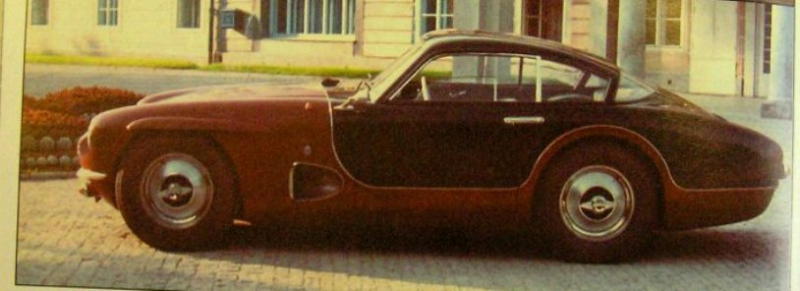
In the 50s, after the Czechoslovak roads plowed most Spartak. A magnificent machine Júlia Kubinského, which almost got into production.
Roadsters or grand tourer and communist Czechoslovakia and do not go together too.However, there have been attempts, but all ended in failure more or less, and often it was the intervention of the communist government. Consider need for Skoda 110 Super Sport from 1969 or even on older piece of Skoda 1100 OHC 50s, which is still so beautiful until nejednomu petrolhead knees go weak.
Skoda, however, not only produced concepts that get into production was not realistic. Tatra to also have something to say and the machine, you are looking at the photos, also bears her name. It’s Tatra JK 2500, which worked designer Julius Kubinská in the first half of the 50s.He had gone through years of work on other cars, including those that were built on the foundations of the German military machine KdF. Also in Brno, just after the Second World War built racing cars with engines Alfa Romeo or BMW.
JK 2500 is the ninth Kubinského machine and began to take shape in 1951 – 1952. Kubinská was working in Brno Karosa and its management considered what will be produced, to cease military production. This however did not happen and the plant spewed box bodies to immortal Praga V3S. Yet in 1952 he created Kubinská along with sixteen other employees of Karosa main part of JK 2500, but had reportedly postponed the project until 1955. At that time he was finished, he in his spare time and in my own garage.
Interesting is definitely chassis. Front axle has been modified German car KdF and workshops VW / Porsche apparently came too tender. Rear axle De Dion has worked, which has a differential securely attached to the car chassis, two swinging half-axles and called. De Dion tube. It provides, in simple terms, that both wheels have the same deflection at any moment. If one wheel moves on inequality, the latter also lists, but will remain in contact with bitumen. If both wheels at once on the same inequality simultaneously, eg. A transverse wave in the asphalt, just this pipe to ensure that they have the best possible contact with the road.Compared to modern McPherson or double wishbones it looks pretty outdated, but remember that we are in 1951. De Dion axle is still better than a torsion beam axle or swinging before he was fitted for example. Mercedes 300 SL Gullwing .
Beautiful body JK 2500 is based on the spatial tubular frame on which are mounted an outer sheets. All parts of the frame were reportedly made of seamless pipes from normal trade, but some parts are a bit modified. Custom parts produced in minumum chassis, body panels are hand-hammering under the leadership of a body builder, John Heger. Wire wheels have a diameter of 16 “and are derived as well as drum brakes of Lancia Aurelia.
Also notice the use of two fuel tanks, each with a capacity of about 30 liters that have been placed behind the rear wheels. Rear overhang of this car is not entirely a small, after all, the machine has a wheelbase of 2300 mm and the length is 4050 mm. For comparison, Favorit had a wheelbase of over 2,4 meters. And the weight? Empty JK 2500 weighed 1,160 kilograms and the weight distribution ratio of 51:49 front: rear axle.
Under the hood was initially a 2.5-liter inline six-cylinder Alfa Romeo, which gave 90 horses.The four-speed gearbox also came from Alfa Romeo, but even then there were thoughts of Czechoslovak osmiválec. And when it was completed the development of air-cooled 2.5 liter V8 Tatra, this engine just went under the hood. Get it certainly was not easy, even when the entire Tatra 603 for which it was designed this eight-cylinder engine, was not normally buy.
Tatra osmiválec originally said about the performance of only 75 horses under the hood hardly made it, some parts had to be modified and had created a spacer that could consolidate the Italian transmission, but finally came. Even large coolers could disappear, because this engine has liquid cooling. In their place and could move into the spare wheel.Only this engine but it was the reason why the Tatra truck appoints JK 2500, construction of Tatra originates and is sometimes mistakenly attributed to her.
The heated air from the motor is directly fed by the front glass, which was needed in winter, it was excellent heating. Conscription, however, was insufficient, and later moved in behind the front wheels have chrome vents, which helped divert hot air from the engine. Obviously it was quite a lot.
Official presentation of the car came in 1958 in Kopřivnice, although in the World Engine with the headline “Also, we can do it ‘this car already appeared in 1956. It was a great success, but also the attention of the authorities,” the wrong “- where he took his Kubinská construction money, was one of their questions. For now, however, came Tatry offer the manufacture and sale of five units of this car. It was also associated with the position of the developer in Tatra.
Production has finally taken place, but the car was tested two weeks in Koprivnice. Then, under his hood also he got V8 engine with full power, such as it was in the Tatra 603, ie 140 hp. Also at that time on the car was a new fifteen-alloy wheels whose openings stretched when driving the cooling air to the drum brakes. They have a smaller diameter compared to the original, but he was effective.
Julius Kubínská with this car, then drove 13 years in normal operation, but to no production occurred, even short-run. All the commotion woke appropriate, this car was in the Czechoslovak roads revelation, no one else had such. But look at him, not given to much contemporary Ferrari. Kubínská later sold the car and where it is now, we do not know.Perhaps somewhere in the barn waiting to be discovered and renovation …
Original URL: http://www.autoforum.cz/fascinace/tatra-jk-2500-ceske-ferrari-z-50tych-let-bere-dech-jeste-dnes/
August 9th, 2015
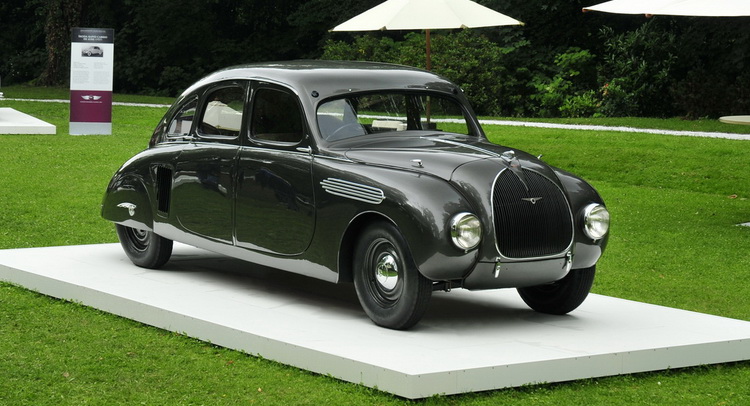
Skoda is celebrating 120 years of existence this year and took nine of its rarest classics at the Bensberg Classics exhibition near Cologne, Germany.
The major attraction was of course the Skoda 935 Dynamic prototype, a streamlined concept dating back to 1935 which was carefully restored back to its original condition by Skoda themselves.
This is after all the only one in existence globally, with its last public appearance set back in October 1935(!) at the Motor Show in Prague where the Skoda 935 Dynamic made its debut. With its teardrop-shaped body, the 935 was exhibiting one of the most progressive designs in the auto industry at the time.
The mid-engined concept is using a body made out of aluminum/steel composite which kept the weight figure down at 1170kg. The water-cooled flat-four 2.0-litre engine is mounted in front of the rear axle and produces 54hp, enough the take the aerodynamic 935 at speed up to 140km/h. Measuring 4.86m in length, 1.68m wide and 1.54m high, this Skoda prototype is a testament of the innovative power that fuelled Skoda back then.
The car was a part of a private collection from 1939 and up until 1968 where the then newly-founded Skoda Museum bought it with Skoda deciding a full restoration back to its original glory in 2012.
Skoda showcased nine cars in total, with the rest of them to be the Laurin & Klement Voiturette A (1905), Laurin & Klement Type S (1911), Laurin & Klement 110 (1925), ŠKODA 645 (1930), ŠKODA Rapid Cabrio de Luxe (1937), ŠKODA Superb OHV (1939), ŠKODA Felicia (1961) and the ŠKODA 1100 MBX (1969).
http://www.carscoops.com/2015/07/unique-skoda-935-dynamic-makes-its.html
http://www.praguepost.com/sports/48840-1935-skoda-935-dynamic-goes-to-bensberg-classics
http://www.skoda-auto.com/en/mobile/newsdetail/?newsid=599&nids=600,599,598&lurl=/en/mobile/pages/news.aspx?n=eyJJRCI6Ik5ld3NMaXN0TGl0ZSIsIklzV1AiOmZhbHNlLCJTb3VyY2VVcmwiOiJcL2VuXC9tb2JpbGVcL3BhZ2VzXC9ob21lcGFnZS5hc3B4In0=
August 9th, 2015

f you live in the seventies in Czechoslovakia, you have a plan what you want, but your own supercar can hardly stand. Yet it is not so foolish plans do not give up. Vyučíte the farm machinery repairman and in 1978 go to war. In his free time during the two years of service on the paper design the machine that you definitely resolve to stand.
Thus began the story of graphite, supersport, who designed and built by Ivan Labaška with technology Tatry, just as Julius had Kubinská his “Czech Ferrari” on behalf of Tatra JK 2500 . Words above only very briefly describe how the construction began. Sequel got the job as soon as compulsory military service ended. He continued drawing of individual parts and the small garage putting together a lattice tube frame completely custom designs as the basis of their dream car.
Later he managed to get older Tatra 613, albeit after considerable ups and downs – none other than the government of the car did not belong in the hands. He comes from the chassis and the first motor graphite. However, chassis parts were modified – again by hand. Concept is nevertheless maintained, the engine behind the rear axle, is air-cooled and its 167 horsepower to the rear wheels through a four-speed manual sends transmission.
Graphite body laminate was initially, but that was unique, the forms in which the laminate was formed. Author those machines were cast of concrete, enough unusual material for a mold.Originally, there were tipping headlights and rear completely different than we see in most photos. Lamborghini Countach reportedly the inspiration for the design was not at all – everything was formed from the eye, but also to ensure the best possible aerodynamics.
In parallel with work on building cars Ivan Labaška tried to leave the car also certify that could ride with him in normal operation. You can imagine how difficult it was in an atmosphere of normalization, although weakening. Graphite was physically completed in 1986 but for the purposes of certification had to change the rear portion to resemble the Tatra. When you turn a blind eye, the contours a little “šestsettřináctky” are actually seen.
However, the final consecration to operate on public roads got Graphite after the revolution in 1991. The author then rode with him as he wanted all the time, and even crashed a few times.The car was variously altered and, among other things gradually got carbon fiber bodywork, so that weighs 1.5 tons surely decreased by 50 kg. If you look in detail at some photographs of graphite burgundy paint, the structure of carbon is through a very thin layer of red color clearly visible.
The car later i got a new, fixed lights and drove for some time also with the front bumper in a different color. Compared to its original state has also pulled out fenders. Especially in the rear wheels were needed to expand the body, because there are 17 “wheels with tires of size 335/35 ZR17. In front it is a 275/45 ZR17. Actual dimensions at wheelbase 2500 mm and is 4400 mm in length, 2030 mm in width and 1100 mm in height. brakes on all wheels are four-piston calipers and suspension supplied Sporting HP Czech company, which manufactures racing chassis.
It was in the 90s was also the original engine from Tatra 613 commanded. So instead released a specially-ranking motor racing origins of Tatra 700 GT . It is the same base as the original unit of T613, but has a volume of 4.5 liters, exactly 4423 cm3 drilling stroke of 95.0 mm and 78.0 mm. Maximum output is 294 kW (400 hp) at 7500 rev. / Min, the torque has the highest value of 450 Nm at 6000 rpm. / Min. The aforementioned weight 1,450 kg no surprise impressive dynamics – acceleration value is unknown, a new five-speed gearbox with manual transmission but allows scoot individual gears 87, 149, 204, 269 and 341 km / h. The last digit, also said some sources suggest as maximum speed, but the author talks about the value of 325 km / h.
It makes the car the fastest Czech road machine of all time and we’re not sure whether in the foreseeable future can be overcome anything. Czech road for fastest machine is sometimes considered Tatra MTX V8 , but she did not go so quickly. We can be attributed to the Czech crown the fastest serial car as she Series production was very small, but if they are satisfied with a mere road homologation Graphite has no competition. A reported maximálce at a given power and aerodynamic bodywork certainly convenient to believe.
Nowadays, already with carbon and an extended body, more powerful engine and a new, bright red varnish Ivan Labaška his machine participate in various events, whether on the circuits or “only” meetings. The car has a technical certificate as the year of production recorded in 1991, although the rise began thirteen years before that. There is still reportedly owned by its creator. Up – or perhaps more if – this exceptional car ever you meet you before me have an absolute rarity on the one hand the number of existing pieces, but secondly also a story that stands behind it.
Original text:http://www.autoforum.cz/fascinace/tatra-grafit-je-s-325-km-h-nejrychlejsi-ceske-silnicni-auto/
August 9th, 2015

(+ Video) machine generated to overcome Czech speed record in history finally checked in. Yet in fact, the fastest in its time it was.
When in 1996 the Tatra replaced an aged model 613 newer T700, it was basically a facelift .Large and robust, but still facelift, further development of the T613 model, because the new car also stood on the foundation arose in the seventies. Perhaps because of the Tatra showed her the machine does not belong to the old iron and also to celebrate the centennial anniversary of the automaker decided to build something that can handle more than three hundred aa speed reaches Czech speed record. Thus arose in 1997 model Ecorra Sport V8 outside T700 more than resembled.
Now to achieve a speed record for a flying kilometer, which drove Czech rider on Czech car, this car was designed. T700 chassis adjusted restoration company Ecorra Lubin, hence the car got its name, and the engine comes from Tatra. It was 4,4litrový fork osmiválec air-cooled and filled atmospherically. His output was 400 hp and has a similar engine, which was originally also in the bowels of Tatra 700 GT and appeared also in the Tatra Graphite , although there was a slightly different parameters. The five-speed manual transmission provided power to the rear 18 “wheels, and the car weighed 1,280 kilograms.
The record attempt was planned, but the day before the planned attempt Ecorra after the airport in Hradcany u Mimoně swept Tatra MTX V8 and a record of the fifties overcome – with the result of only 210,895 km / h, although at the end of the flying kilometer car reached 260 km / h. The following day was Ecorra Although quicker, the average speed of two passes of the flying kilometer was 276 km / h, but reportedly able to override table records only once a year, so officially left empty-handed. MTX record remains true today and it is so questionable that Czech car – technically incidentally always Tatra – is actually the fastest real. Whether factory Ecorra, MTX V8 or Graphite Mr. Labaška . In the case of the road it probably will Graphite, an absolute record but it could easily explained and include the right machine.
Subsequently Ecorra V8 moved to the museum in the nearby Tatra Koprivnice and other speed record attempts didnt. Some time later, in 2000, however from there he got into the hands of brothers Hajduškových as a skeleton. He was also acquired engine capacity 4423 cc, the same as in the record attempt. According to some sources, he was now 400 hp and 500 Nm, according to other Newton was 450. The maximum speed is 320 km / h. The reason for the purchase and completion was simple – Ecorra Sport V8 hits the circuit and endurance races. Manual pětikvalt still remained.
It was originally Ecorra red and obviously plastered sponsors, weighed 1,330 kilograms, which is a very serious racer. But this car has a length of 5.1 meters and despite its great weight accelerates to a hundred for four seconds flat. Over the next ten years we could see on Ecorra variety of circuit enterprises in the Czech and Slovak Republics.
Over the years, car doznával course, various changes. Took place mainly in aerodynamics and sometime in 2004, the machine also came with black lacquer. There is also little changed position of the motor, the dimensions of the car dwindled. One of the most intriguing, however, was not visible from the outside. It was the gearbox – the original shell pětikvaltu was custom-made six-speed sequential gearbox. He moved here allegedly being in 2004 when the body of the car was also reduced slightly under five meters and extended from 1.8 meters to two meters straight.
Sport Ecorra then rode in this specification, the lap times of the Brno Masaryk Circuit with modifications car apparently gradually improved from 2:30 to 2:07 for some. In 2007, at the wheel even he sat John Haugland, who perhaps do not imagine especially for those who in past decades watched the Skoda rally.
Sometimes at the beginning of the second decade of the 21st century Ecorra Sport V8, still in black moved into the Sports Car Museum in Lány bit west of Prague and spent several years there. If you have just started looking for a day off, when to go there, we have to disappoint you – this gem is no longer there, the brothers now have Hajdušková him in the garage and said she was trying to put back into working condition. Given that the existing 4,5litrové Tatra V8 engines, one would count on the fingers of one hand, it will not be easy, but let’s fingers crossed. Maybe then we’ll see him in action …
Original URL: http://www.autoforum.cz/fascinace/tatra-ecorra-sport-v8-mela-prepsat-dejiny-ceskych-superaut/
August 9th, 2015
June 26th, 2015
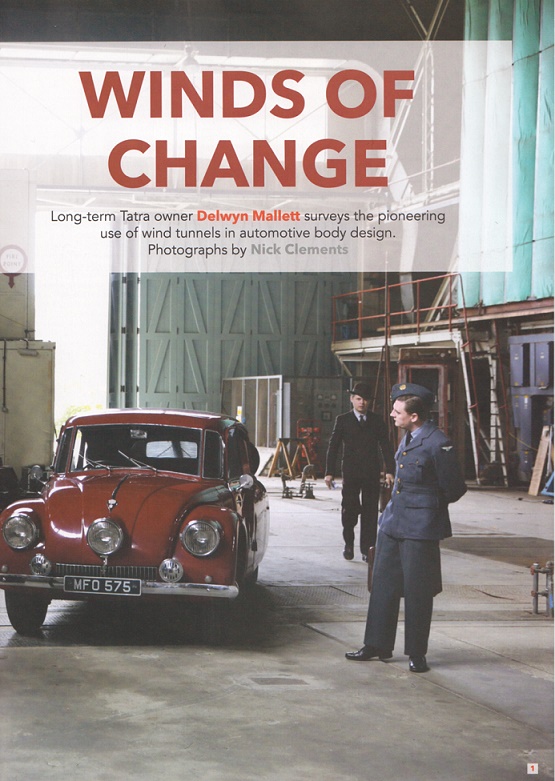
In the July 2015 The Automobile issue, Delwyn Mallet presents a 8 page article on the streamlining of the thirties. He surveys the pioneering use of wind tunnels in automotive body design, focussing on the influential work of Hungarian aerodynamicist Paul Jaray. Two third of the pages are covered with wonderfull purposely made photos in thirties’style made in the Farnborough 24-foot windtunnel as well as contemporary photos.
http://www.theautomobile.co.uk/july-2015-issue/
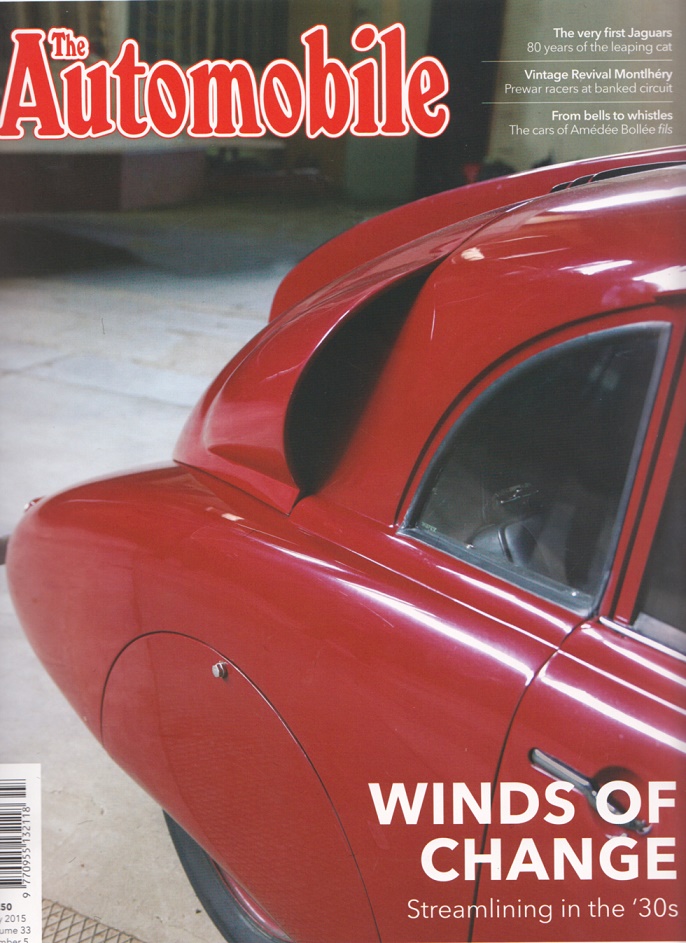
June 22nd, 2015
April 8th, 2015
January 26th, 2015
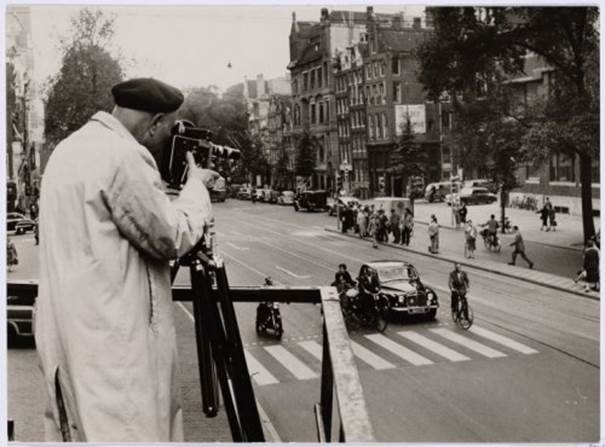
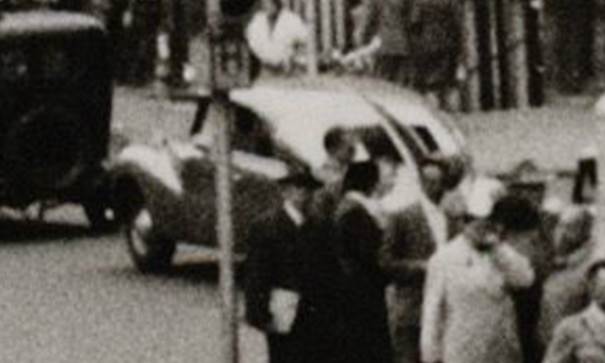
While making a traffic cop police instruction movie on September 1st 1954, this 1949-150 was passing by. T 87s were rare in NL, with less than 20 units imported between 1943 and 1950. (Photo Fred Heddes)
December 19th, 2014





